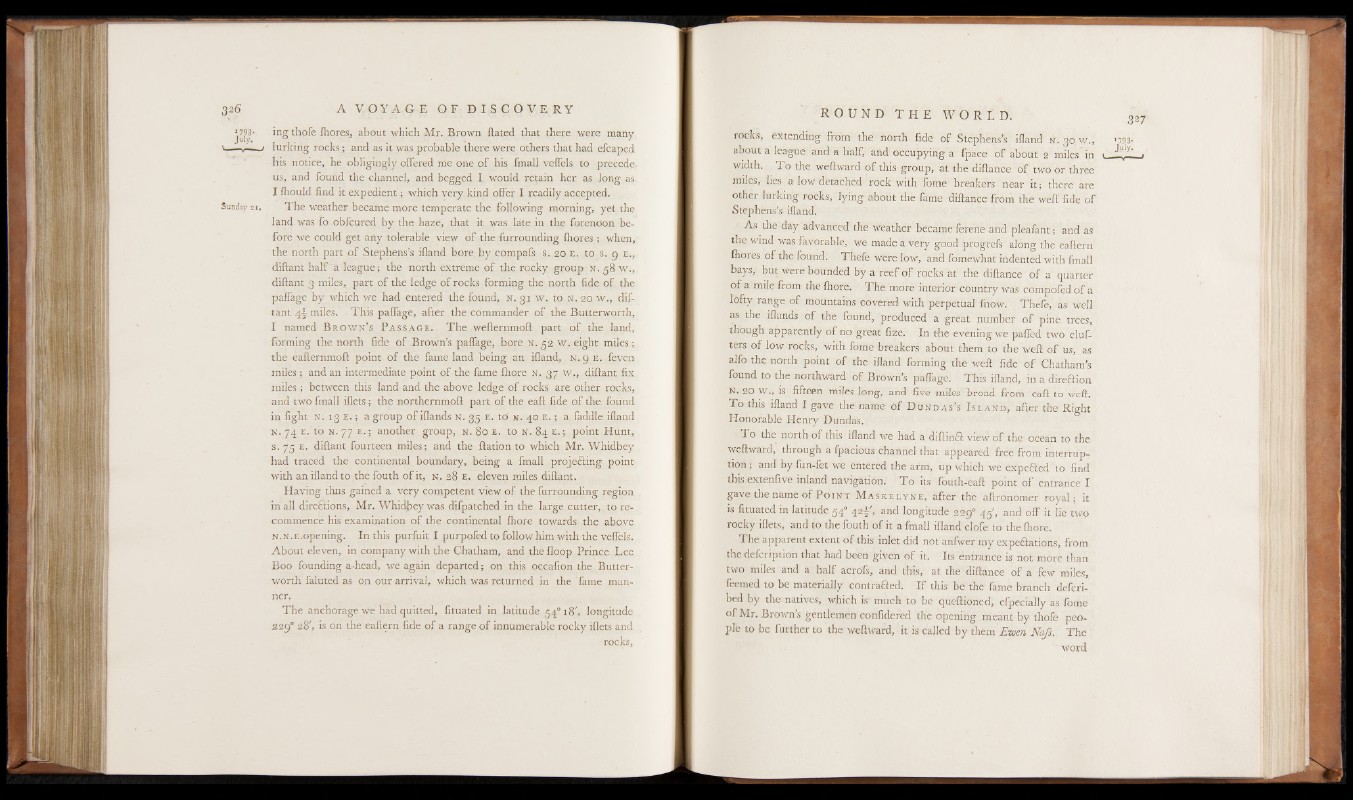
*793- ing thofe Ihores, about which Mr. Brown Hated that there were many
c.— lurking rocks; and as it was probable there were others that had efcaped
his notice, he obligingly offered me one of his fmall veffels to precede,
us, and found the channel, and begged I would retain her as long as
I lhould find it expedient; which very kind offer I readily accepted.
Sunday 21. The weather became more temperate the following morning, yet the
land was fo obfcured by the haze; that it was late in the forenoon before
we could get any tolerable view o f the furrounding Ihores ; when,
the north part of Stephens’s ifland bore by compafs s. 20 E. to s. g e.,
diftant half a league; the north extreme of the rocky group N. 58 w.,
diftant 3 miles, part of the ledge of rocks forming the north fide o f the
paffage by which we had entered the found, N. 31 w. to N. 20 w., diftant
4A miles. This paffage, after the commander of the Butterworth,
I named Brown's Passage.. The wefternmoft part of the land,
forming the north fide of Brown’s paffage, bore N. 52 w , eight miles ;
the eafternmoft point of the fame land being an ifland, N. 9 e. feven
miles ; and an intermediate point of the fame lhore N. 37 w., diftant fix
miles ; between this land and the above ledge of rocks „are other rocks,
and two fmall iflets; the northernmoft part of the eaft fide of the found
in fight N. 13 e. ; a group o f iflands N. 35 E. to" n. 40 e. ; a faddle ifland
N. 74 E. to N. 77 e.; another group, n. 80 E. to n. 84 e.; point Hunt,
s. 75 e. diftant fourteen miles; and the ftation to which Mr. Whidbey
had traced the continental boundary, being a fmall projecting point
with an ifland to the fouth of it, n. 28 E. eleven miles diftant.
Having thus gained a very competent view o f the furrounding region
in all directions, Mr. WhidJjey was difpatched in the large cutter, to recommence
his examination of the continental lhore towards the above
N.N.E.opening. In this purfuit I purpofed to follow him with the veffels.
About eleven, in company with the Chatham, and the Hoop Prince Lee
Boo founding a-head, we again departed ; on this occafion the Butter-
worth faluted as on our arrival, which was returned in the fame manner.
The anchorage we had quitted, fituated in latitude 54“ 18', longitude
229° 28', is on the eaftern fide o f a range of innumerable rocky iflets and
rocks,
rocks, extending from the north fide of Stephens’s ifland n . 30. w., 1793-
about a league and a half, and occupying a fpace of about 2 miles in 1 1“ - ■
width. To the weftward of this group, at the diftance of two or three
miles; lies a low detached rock with fome breakers near i t ; there are
other lurking rocks, lying about the fame diftance from the weft fide of
Stephens’s ifland.
As the day advanced the weather became ferene and pleafant; and as
the wind was favorable, we made a very good progrefs along the eaftern
Ihores of the found. Thefe were low, and fomewhat indented with fmall
bays, but were bounded by a reef o f rocks at the diftance of a quarter
o f a mile from the lhore. The more interior country was compofed of a
lofty range of mountains covered with perpetual fnow. Thefe, as well
as the iflands of the found, produced a great number o f pine trees,
though apparently of no great fize. In the evening we paffed two cluf-
ters o f low rocks, with fome breakers about them to the weft of us, as
alfo the north point of the ifland forming the weft fide o f Chatham’s
found to the northward o f Brown’s paffage. This ifland, in a diredtion
N. 20 w,, is fifteen miles long, and five miles broad from eaft to weft.
T o this ifland I gave the name o f Donbas's Island, after the Right
Honorable Henry Dundas.
T o the north of this ifland we had a diftindt view of the ocean to the
weftward, through a fpacious channel that appeared free from interruption
; and by fun-fet we entered the arm, up which we expefted to find
this extenfiye inland navigation. To its fouth-eaft point of entrance I
gave the name of Po 1N t Ma sk e l yne , after the aftronomer royal; it
is fituated in latitude 34° 4~2" > and longitude 2290 45’, and off it lie two
rocky iflets, and to the fouth o f it a fmall ifland clofe to the lhore.
The apparent extent o f this inlet did not anfwer my expedtations, from
the defcription that had been given of it. Its entrance is not more than
two miles and a half acrofs, and this, at the diftance of a few miles,
feemed to be materially contradled. I f this be the fame branch defcri-
bed by the natives, which is- much to be queftioned, efpecially as fome
of Mr. Brown’s gentlemen confidered the opening meant by thofe peo-
ple to be further to the weftward, it is called by them Ewen Nafs. The
word